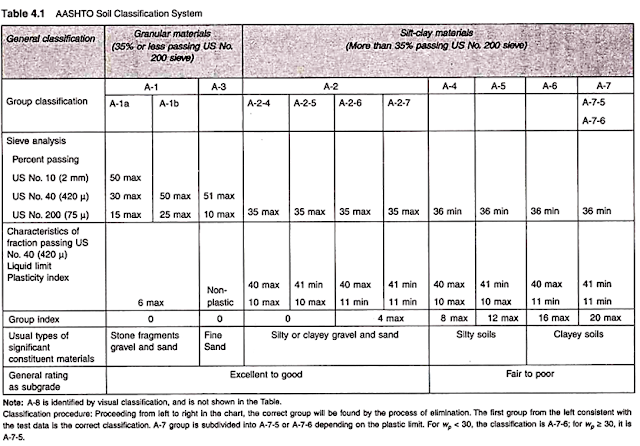Comparison: AASHTO & Unified Soil Classification System
Comparison between AASHTO and unifical soil classification system
Comparison # AASHTO M145 Classification System:
American Association of State Highway and Transport Officials (AASHTO) soil classification system is based on both the particle size and the plasticity characteristics.
According to this system, soils are classified into eight groups A-1 to A-8, the last being peat or muck. Soils within each group are evaluated according to the group index (GI) calculated from the following empirical formula –
GI = 0.2 a + 0.005 ac + 0.01 bd
Where a = that part of the percent passing US sieve No. 200 greater than 35, and not exceeding 75, expressed as a positive whole number (1 to 40);
b = that part of the percent passing US sieve No. 200 greater than 15, and not exceeding 55 expressed as a positive whole number (1 to 40);
c = that part of the liquid limit greater than 40, and not greater than 60, expressed as a positive whole number (1 to 20), and
d = that part of the plasticity index greater than 10 and not exceeding 30, expressed as a positive whole number (1 to 25).
The group index value should be rounded off to the nearest integer; in case any of the above values is less than the minimum limit, it should be taken as zero. The details of the groups and subgroups are set out in Table 4.1.
Comparison # Unified Soil Classification System (USCS):
The Unified Soil Classification System is a modified version of a Casagrande’s Airfield Classification (AC) System developed by him in 1942 for the Corps of Engineers, USA. Since 1942, the original classification system has been expanded and revised in cooperation with Bureau of Reclamation, USA, so as to make it applicable to other fields as well, viz., embankments, foundations and other engineering features.
The USCS was adopted in 1952. In 1969, the American Society for Testing and Materials (ASTM) adopted the Unified System as a standard method for classification for engineering purposes.
The system uses both the particle size analysis and plasticity characteristics of soils. In this system, the soils are classified into 15 groups.
As given in Table 4.2, the soils are broadly classified into two categories:
(1) Coarse-Grained Soils:
G = Gravel and gravelly soils
S = Sand and sandy soils
The gravel and sand are further divided into subgroups as:
W = Well graded, fairly clean material
C = Well graded with excellent clay binder
P = Poorly graded, fairly clean material
F = Coarse material containing fines not included in preceding groups.
(2) Fine-Grained Soils:
M = Inorganic silty and very fine sandy soils
C = Inorganic clays
O = Organic silts and clays
P = Peat
The above groups of the fine-grained soils (excluding peat) are further subdivided according to their liquid limits into:
P = Peat
L = Fine-grained soils with liquid limits below 50, indicating low to medium compressibility of plasticity characteristics.
H = Fine-grained soils with liquid limits above 50 indicating high compressibility or plasticity characteristics.
The type of soil is indicated by a suitable combination of symbols such as:
GW = Well graded gravels or gravel-sand mixture with little or no fines.
GC = Clayey gravels or sand-clay mixtures.
SC = Clayey sands or sand clay mixtures.
ML = Inorganic silt with low to medium compressibility.
CH = Inorganic clays of high plasticity.
Table 4.2 gives the groupings for coarse-grained and fine-grained soils. The classification of fine-grained soils is easier to understand on Casagrande’s plasticity chart as described in Fig. 4.1.
When the plasticity index and the liquid limit plot in the hatched portion of the plasticity chart, the soil is given double symbol CL-ML.
The inorganic soils ML and MH and the organic soils OL and OH plot in the same zone of the plasticity chart. The distinction between the inorganic and organic soils is made by oven-drying. If the drying decreases the liquid limit by 30% or more, the classified soil is organic (OL or OH), otherwise inorganic (ML or MH).
Highly Organic Soils:
Highly organic soils are identified by usual inspection. These soils are termed as peat (Pt).






Comments
Post a Comment